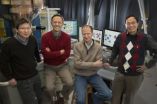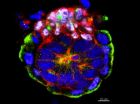(Press-News.org) Can more accurate climate models help us understand extreme weather events? Can we use
synthetic biology to create better biofuels? These questions, and the ongoing search for Dark
Matter and better photovoltaic materials, are just some of the presentations by Lawrence
Berkeley National Lab researchers at this year's AAAS meeting. Here's a quick look at Berkeley
Lab@AAAS:
Friday, Feb. 14
1:00-2:30
Opportunities for New Materials in
Photovoltaics (Toronto Room, Hyatt Regency)
Ramamoorthy Ramesh
The
Department of Energy's SunShot Initiative is a collaborative national program to make solar
energy cost competitive with other forms of energy by the end of the decade. Reducing the
installed cost of solar energy systems by about 75% will drive widespread, large-scale adoption
of this renewable energy technology and restore U.S. leadership in the global clean energy race.
This talk outlines the most promising options in emerging materials for photovoltaics.
1:30-4:30
Research Challenges Affecting Extreme Events in a Changing Climate
(Grand Ballroom B, Hyatt)
Michael Wehner Extreme weather and climate events can have
serious impacts on human and ecological systems. Changes in the magnitude and frequency of
extreme weather associated with changes in the average climate are likely the most serious
consequence of human induced global warming. Understanding what the future portends is vital if
society hopes to adapt to a very different world. As average temperatures continue to rise due
to the human changes to the composition of the atmosphere, it is very likely that events we
currently consider to be heat waves will occur more frequently and be more severe over the
course of this century. In fact, events that are currently considered rare will likely become
commonplace. Accurate simulation of precipitation presents a much more difficult problem to
climate models than does temperature.
Saturday, Feb. 15
8:30-11:30
U.S.
National User Facilities: A Major Force for Discovery and Innovation (Columbus EF,
Hyatt)
Roger Falcone: Materials in Extreme Conditions: Science Across a Range of
Facilities
This presentation will describe research at a range of national user facilities that
involves the study of materials under extreme conditions. The facilities range from a
synchrotron x-ray source, to an intermediate-scale laser facility, to the world's first x-ray
laser, to the world's largest laser. These DOE-funded facilities have a variety of missions and
provide different experiences, but each provides a unique capability for scientists to probe the
structure and dynamics of matter at extreme temperatures, pressures, and densities.
1:30-4:30
Is It Possible to Reduce 80% of Greenhouse Gas Emissions from Energy by
2050? (Columbus CD, Hyatt)
Jeff Greenblatt
Even if all efforts are made to reduce fuel
use, some mobile sources will require liquid or gaseous fuels. Biofuels could be made with a
lower carbon signature, but we are unlikely to have enough of them to meet all our needs in a
de-carbonized energy system. A few ideas for filling this fuel gap are expensive or complex. We
need to invest in a number of these if we are to decarbonize the fuel supply.
Engineering
Hydrocarbon Production (Regency B, Hyatt)
Jay D. Keasling This
talk will describe how tools of synthetic biology have been used to engineer hydrocarbon
metabolism in microorganisms for production of advanced fuels, including diesel, gasoline, and
jet fuel replacements.
Sunday, Feb. 16
1:30-4:30
The Cryogenic Dark Matter
Search (Columbus IJ, Hyatt Regency)
Bernard
Sadoulet
The recent results from the Planck satellite confirm that a staggering 85 percent of
matter in the universe is a new form not accounted for by the Standard Model of particle
physics. Leading particle candidates for dark matter are weakly interacting massive particles
(WIMPs). The WIMP is strongly motivated by supersymmetry and detectable also as a product of the
highest energy proton-proton collisions at the Large Hadron Collider. Several experiments
attempting to directly detect dark matter particles streaming from space have already reported
puzzling results with possible signals. New "telescopes" like Fermi, AMS, and IceCube can detect
WIMP dark matter particles annihilating in space. Major discoveries may be imminent, as a
multi-pronged experimental program moves forward rapidly, driving technological innovations for
ultra-sensitive detectors.
INFORMATION: END
Berkeley Lab researchers at AAAS 2014
Media tip sheet
2014-02-14
ELSE PRESS RELEASES FROM THIS DATE:
Superconductivity in orbit: Scientists find new path to loss-free electricity
2014-02-14
UPTON, NY—Armed with just the right atomic arrangements, superconductors allow electricity to flow without loss and radically enhance energy generation, delivery, and storage. Scientists tweak these superconductor recipes by swapping out elements or manipulating the valence electrons in an atom's outermost orbital shell to strike the perfect conductive balance. Most high-temperature superconductors contain atoms with only one orbital impacting performance—but what about mixing those elements with more complex configurations?
Now, researchers at the U.S. Department of ...
Rewriting the text books: Scientists crack open 'black box' of development
2014-02-14
We know much about how embryos develop, but one key stage – implantation – has remained a
mystery. Now, scientists from Cambridge have discovered a way to study and film this 'black box'
of development. Their results – which will lead to the rewriting of biology text books worldwide
– are published in the journal Cell. Embryo development in mammals occurs in two phases.
During the first phase, pre-implantation, the embryo is a small, free-floating ball of cells
called a blastocyst. In the second, post-implantation, phase the blastocyst embeds itself in the
mother's ...
A role of glucose tolerance could make the adaptor protein p66Shc a new target for cancer and diabetes
2014-02-14
[TORONTO,Canada, Feb 18, 2014] – A protein that has been known until recently as part of a complex communications network within the cell also plays a direct role in regulating sugar metabolism, according to a new study published on-line in the journal Science Signaling (February 18, 2014).
Cell growth and metabolism are tightly controlled processes in our cells. When these functions are disturbed, diseases such as cancer and diabetes occur. Mohamed Soliman, a PhD candidate at the Lunenfeld Tanenbaum Research Institute at Mount Sinai Hospital, found a unique role for ...
IBEX research shows influence of galactic magnetic field extends beyond our solar system
2014-02-14
In a report published today, new research suggests the enigmatic "ribbon" of energetic
particles discovered at the edge of our solar system by NASA's Interstellar Boundary Explorer (IBEX)
may be only a small sign of the vast influence of the galactic magnetic field.
IBEX researchers have sought answers about the ribbon since its discovery in 2009. Comprising
primarily space physicists, the IBEX team realized that the galactic magnetic field wrapped around
our heliosphere — the giant "bubble" that envelops and protects our solar system — appears to
determine the orientation ...
Rebuilding the brain after stroke
2014-02-14
DETROIT – Enhancing the brain's inherent ability to rebuild itself after a stroke with molecular
components of stem cells holds enormous promise for treating the leading cause of long-term
disability in adults.
Michael Chopp, Ph.D., Scientific Director of the Henry Ford Neuroscience Institute, will present
this approach to treating neurological diseases Thursday, Feb. 13, at the American Heart
Association's International Stroke Conference in San Diego.
Although most stroke victims recover some ability to voluntarily use their hands and other body
parts, half are ...
Amidst bitter cold and rising energy costs, new concerns about energy insecurity
2014-02-14
February 13,2014 --With many regions of the country braced by an unrelenting cold snap, the problem of energy insecurity continues to go unreported despite its toll on the most vulnerable. In a new brief, researchers at Columbia University's Mailman School of Public Health paint a picture of the families most impacted by this problem and suggest recommendations to alleviate its chokehold on millions of struggling Americans. The authors note that government programs to address energy insecurity are coming up short, despite rising energy costs.
Energy Insecurity (EI) is ...
Harvard scientists find cell fate switch that decides liver, or pancreas?
2014-02-14
Harvard stem cell scientists have a new theory for how stem cells decide whether to become
liver or pancreatic cells during development. A cell's fate, the researchers found, is determined by
the nearby presence of prostaglandin E2, a messenger molecule best known for its role in
inflammation and pain. The discovery, published in the journal Developmental Cell, could potentially
make liver and pancreas cells easier to generate both in the lab and for future cell therapies.
Wolfram Goessling, MD, PhD, and Trista North, PhD, both principal faculty members of the
Harvard ...
Arctic biodiversity under serious threat from climate change according to new report
2014-02-14
Unique and irreplaceable Arctic wildlife and landscapes are crucially at risk due to global warming caused by human activities according to the Arctic Biodiversity Assessment (ABA), a new report prepared by 253 scientists from 15 countries under the auspices of the Conservation of Arctic Flora and Fauna (CAFF), the biodiversity working group of the Arctic Council.
"An entire bio-climatic zone, the high Arctic, may disappear. Polar bears and the other highly adapted organisms cannot move further north, so they may go extinct. We risk losing several species forever," says ...
Pregabalin effectively treats restless leg syndrome with less risk of worsening symptoms
2014-02-13
A report in the Feb. 13 New England Journal of Medicine confirms previous studies suggesting that long-term treatment with the type of drugs commonly prescribed to treat restless leg syndrome (RLS) can cause a serious worsening of the condition in some patients. The year-long study from a multi-institutional research team found that pregabalin – which is FDA-approved to treat nerve pain, seizures, and other conditions – was effective in reducing RLS symptoms and was much less likely to cause symptom worsening than pramipexole, one of several drugs that activate the dopamine ...
Environment change threatens indigenous know-how
2014-02-13
The way indigenous cultures around the globe use
traditional medicines and pass on knowledge developed over centuries is directly linked to the
natural environment, new research has found. This makes indigenous cultures susceptible to
environmental change, a threat that comes on top of the challenges posed by globalisation.
"Traditional medicine provides health care for more than half the world's population, with 80 per
cent of people in developing countries relying on these practices to maintain their livelihood. It
is a very important part of traditional knowledge," ...
LAST 30 PRESS RELEASES:
Duke and Duke-NUS’ joint cross-population research to uncover "East-West" differences in disease and care
Scientists to ‘spy’ on cancer- immune cell interactions using quantum technology breakthrough
Tech savvy users have most digital concerns
Making lighter work of calculating fluid and heat flow
Normalizing blood sugar can halve heart attack risk
Lowering blood sugar cuts heart attack risk in people with prediabetes
Study links genetic variants to risk of blinding eye disease in premature infants
Non-opioid ‘pain sponge’ therapy halts cartilage degeneration and relieves chronic pain
AI can pick up cultural values by mimicking how kids learn
China’s ecological redlines offer fast track to 30 x 30 global conservation goal
Invisible indoor threats: emerging household contaminants and their growing risks to human health
Adding antibody treatment to chemo boosts outcomes for children with rare cancer
Germline pathogenic variants among women without a history of breast cancer
Tanning beds triple melanoma risk, potentially causing broad DNA damage
Unique bond identified as key to viral infection speed
Indoor tanning makes youthful skin much older on a genetic level
Mouse model sheds new light on the causes and potential solutions to human GI problems linked to muscular dystrophy
The Journal of Nuclear Medicine ahead-of-print tip sheet: December 12, 2025
Smarter tools for peering into the microscopic world
Applications open for funding to conduct research in the Kinsey Institute archives
Global measure underestimates the severity of food insecurity
Child survivors of critical illness are missing out on timely follow up care
Risk-based vs annual breast cancer screening / the WISDOM randomized clinical trial
University of Toronto launches Electric Vehicle Innovation Ontario to accelerate advanced EV technologies and build Canada’s innovation advantage
Early relapse predicts poor outcomes in aggressive blood cancer
American College of Lifestyle Medicine applauds two CMS models aligned with lifestyle medicine practice and reimbursement
Clinical trial finds cannabis use not a barrier to quitting nicotine vaping
Supplemental nutrition assistance program policies and food insecurity
Switching immune cells to “night mode” could limit damage after a heart attack, study suggests
URI-based Global RIghts Project report spotlights continued troubling trends in worldwide inhumane treatment
[Press-News.org] Berkeley Lab researchers at AAAS 2014Media tip sheet




